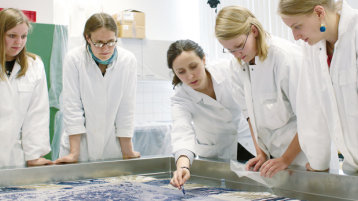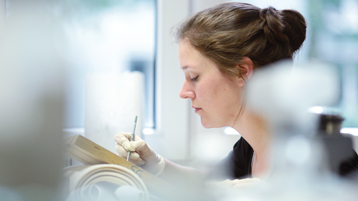Conservation and handling of library collections containing arsenic
Consolidation of underbound pigment on book edges
At a glance
| Kategorie | Beschreibung |
|---|---|
| Student project | Conservation and handling of library collections containing arsenic |
| CICS department | Documents, graphics, photography and book illumination |
| Student | Juliana Wetten, B.A. |
| Supervisors | Marlen Börngen, M.A. |
| Prof. Dr. Andrea Pataki-Hundt | |
| Project partners | Bonn University and State Library |
| Duration | 2021 |
Picture gallery
 0 / 0
0 / 0
Object from the university library in Bonn. The arsenic pigment Schweinfurt Green was applied to all three edges of the book. The pigment layer is underbound and poses a health and safety hazard. (Image: TH Köln - CICS - Juliana Wetten)
 0 / 0
0 / 0
The tesa adhesive strip was pressed onto the book edge for a determined time using a constant weight. (Image: TH Köln - CICS - Juliana Wetten)
When dealing with cultural assets, there often is the possibility of an object containing some form of hazardous material. In recent years there have been several discoveries of books containing arsenical pigments as part of the binding or on the edges. These findings have raised questions concerning the health and safety of workers handling these objects.
Within the context of the research project “Enabling the use of arsenic bindings”, a collaboration between the University Library of Bonn and the CICS, this bachelor thesis looked into underbound pigment layers on book edges containing arsenic. Because loose pigments pose a higher health risk, possibilities of consolidation and their effectiveness were evaluated.
Arsenic pigments: Occurence and toxicology
The most used arsenic pigments are the yellow Orpiment as well as Scheele Green and Schweinfurt Green (also Emerald Green) (Fig. 1). Orpiment was used as early as 1500 B.C., often in combination with blue pigments to make a dark green colour. The green pigments were first developed in the 19th century and were used in different areas. In 1887, their production was prohibited.
The poisonous properties of arsenic were well known when the green pigments were first developed. Arsenic can affect the cardiovascular system, the gastro-intestinal-system, the metabolism as well as the nervous system. Typical symptoms would be headache, nausea and vomiting, diarrhoea as well as sleeplessness and shortness of breath. Chronic exposition increases the risk of cancer.
Consolidation of underbound pigment on book edges
While turning the pages of a book, handling of objects and in particular while cleaning with brushes or sponges, pigments can get loose and stick to surfaces or to hands. Therefore, different means of consolidation and their success in securing loose pigments were evaluated in a series of tests.
Four common consolidants in varying concentrations were applied to samples, which consisted of book blocks with an underbound pigment layer. Three types of application of the consolidant were compared: with a brush, as an aerosol and with airbrush. The success of the consolidation was measured by pressing a Tesa adhesive strip onto the edges. After peeling off the strip, the amount of pigment that sticked onto the tape was measured and compared (Fig. 2 + Fig. 3). The most promising result were achieved when using Klucel G dissolved in ethanol (3% w/v) and was therefore applied to books from the university library Bonn.
Results and conclusion
The success of the treatment of arsenic pigments was measured again with adhesive strips, but in addition to that, a microchemical arsenic test was carried out (Fig. 4). The MQuandtTM arsenic test kit can be used to analyse aqueous samples. Existing arsenic is indicated a by colour change, that ranges from yellow to brown. Using a dry cotton swab, wipe samples were collected before and after consolidation. The samples were added to water and the colour change was compared. This arsenic test was helpful to determine if the amount of arsenic in a wipe sample could be reduced by means of consolidation.
The chosen application of three layers of Klucel G (3% w/v) to the edges containing arsenic was not as effective as anticipated. However, using Klucel E dissolved in ethanol (8% w/v) in a combination with the solution of Klucel G proofed to be very effective. The consolidation of underbound pigment layers on edges should be tested and refined in the future. However, the work in this thesis could show that the risk for workers and readers handling books containing arsenic can be reduces significantly by means of consolidation.







